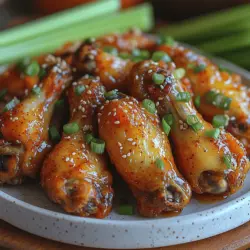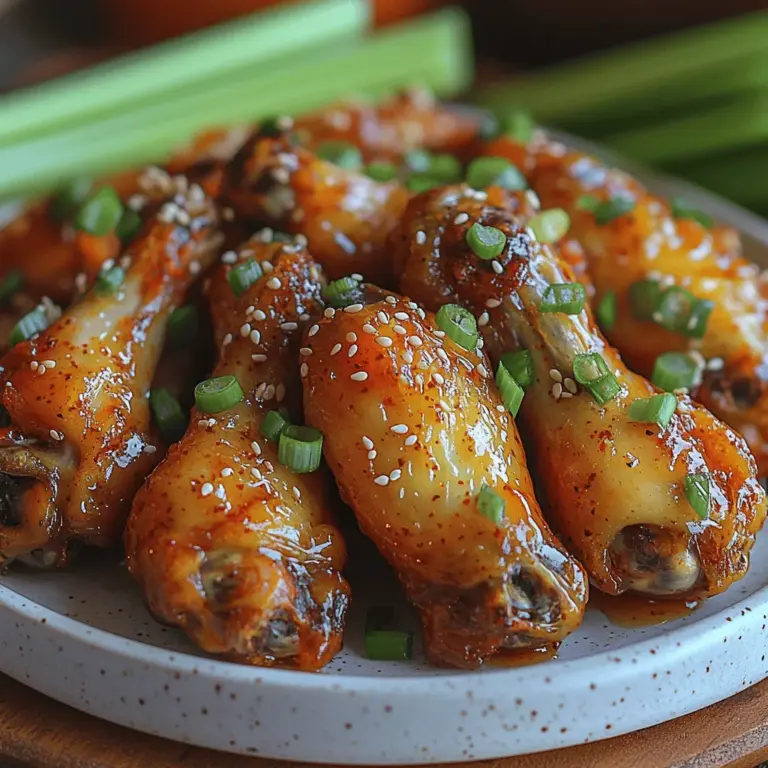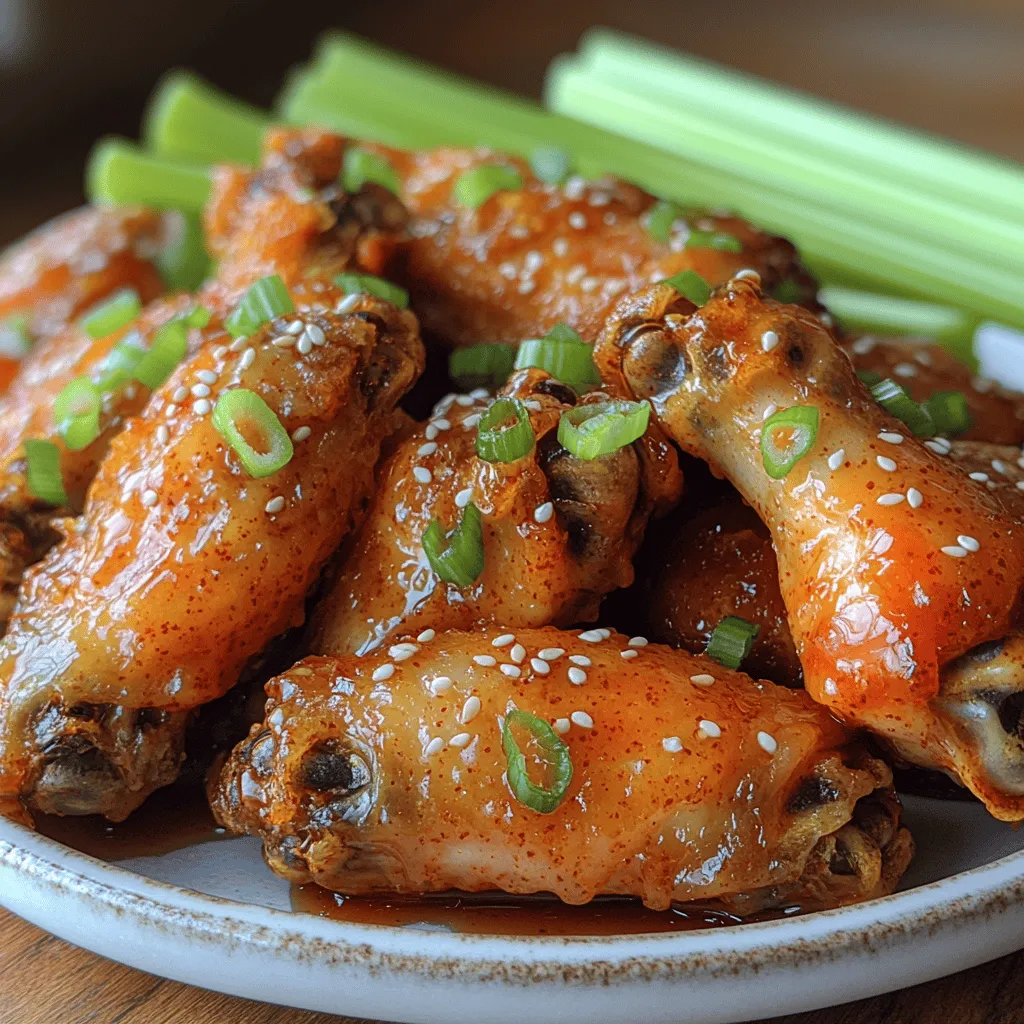Spicy Honey Garlic Chicken Wings Recipe
Introduction
Chicken wings have long held a special place in the hearts of food lovers everywhere, making them an iconic appetizer or party food. Their irresistible combination of crispy skin and juicy meat has made them a staple at gatherings ranging from casual family dinners to lively game day celebrations. Among the myriad of flavor profiles that can be applied to chicken wings, the spicy honey garlic variation stands out for its perfect balance of sweetness, heat, and savory depth. This dish marries the rich flavors of honey and garlic with a kick of spice, creating a tantalizing experience that keeps diners coming back for more.
The beauty of spicy honey garlic chicken wings lies in their versatility. Whether you’re hosting a Super Bowl party, throwing a backyard barbecue, or simply looking for a delicious dinner option, these wings fit the bill perfectly. They can be served as a finger-licking appetizer or a main dish, satisfying a range of palates and occasions. The balance of flavors in this recipe means it appeals to those who enjoy a hint of sweetness as well as those who crave a bit of heat, making it a crowd-pleaser.
Understanding the Ingredients
To create the perfect batch of spicy honey garlic chicken wings, it’s essential to understand the role of each ingredient. This dish features a harmonious blend of flavors that come together to elevate the humble chicken wing into a standout dish.
1. Chicken Wings: The star of the show, chicken wings come in various types, including drumettes, flats, and whole wings. For this recipe, it’s recommended to use a mix of drumettes and flats for textural contrast. When preparing the wings, ensure they are thoroughly thawed if frozen and pat them dry with paper towels. This step is crucial for achieving that coveted crispy skin.
2. Honey: Acting as the sweet backbone of the sauce, honey not only balances the heat but also caramelizes beautifully during cooking, creating a glossy, sticky coating. Opt for a high-quality, pure honey to achieve the best flavor.
3. Soy Sauce: This ingredient enhances the umami profile of the dish, providing a salty depth that complements the sweetness of the honey. Using low-sodium soy sauce can help control the saltiness, allowing for a more balanced dish.
4. Sriracha Sauce: For those who enjoy a bit of heat, Sriracha is an excellent addition. Its garlicky undertones and adjustable spice levels can be tailored to your personal preference—add more for a fiery kick or less for a milder flavor.
5. Garlic and Ginger: Fresh garlic and ginger add aromatic complexity to the wings. Garlic imparts a rich, savory flavor, while ginger contributes a peppery warmth that brightens the dish.
6. Apple Cider Vinegar: This ingredient introduces acidity, cutting through the richness of the honey and chicken. It enhances the overall flavor profile, adding brightness and balance to the dish.
7. Sesame Oil: A drizzle of sesame oil provides a nutty undertone that deepens the flavor of the wings. It’s a small addition that makes a significant impact.
8. Seasonings: Basic seasonings such as black pepper and salt are essential for enhancing the overall flavor. These simple additions ensure that every bite is well-seasoned and satisfying.
Marinating the Chicken Wings
Marinating the chicken wings is a critical step in this recipe, as it allows the flavors to penetrate the meat, resulting in a more flavorful dish. The marinade, made from a mixture of honey, soy sauce, Sriracha, garlic, ginger, and apple cider vinegar, coats the wings evenly and infuses them with flavor.
For optimal taste, it’s recommended to marinate the wings for at least 1 hour; however, for the best results, aim for 4 to 12 hours. This extended marinating time allows the flavors to meld and develop, giving the wings a robust taste.
When it comes to marinating, using a resealable plastic bag is one of the most effective methods. This allows for even coating and ensures that all the wings are submerged in the marinade. Simply place the wings in the bag, pour in the marinade, seal it tightly, and give it a gentle shake to evenly distribute the mixture. Refrigerate the bag, turning it occasionally to ensure all surfaces of the wings absorb the flavors.
Frying Techniques for Perfectly Crispy Wings
Once the wings have marinated to perfection, it’s time to focus on the cooking method. Achieving a perfectly crispy exterior is key to the ultimate chicken wing experience. There are two primary frying methods to consider: deep frying and air frying.
– Deep Frying: This traditional method involves submerging the wings in hot oil, resulting in a crispy texture that is hard to beat. To deep fry, heat oil in a deep fryer or a heavy pot to about 350°F (175°C). Working in batches, carefully add the marinated wings and fry until golden brown and cooked through, usually about 8-10 minutes. Be sure to monitor the temperature of the oil to maintain optimal frying conditions, and allow the wings to drain on paper towels afterward.
– Air Frying: For a healthier alternative, air frying is an excellent option. Preheat the air fryer to 375°F (190°C) and arrange the marinated wings in a single layer in the basket, ensuring they are not overcrowded. Air fry for about 25-30 minutes, flipping halfway through for even cooking. The result is a crisp exterior with significantly less oil than deep frying.
In either method, the key to achieving a crispy wing is to ensure they are well-dried before cooking and to avoid overcrowding the cooking vessel. This allows the hot air or oil to circulate freely around the wings, promoting an even and crispy finish.
As you embark on this culinary journey of creating spicy honey garlic chicken wings, the combination of marinating and frying techniques will ensure a delicious outcome that is sure to impress family and friends alike.
Instructions for Preparing the Oil and Achieving the Right Frying Temperature
To achieve perfectly crispy and golden brown chicken wings, the right frying temperature is crucial. Begin by selecting a heavy-bottomed pot or deep-fryer, as these tools help maintain consistent heat. Fill your pot or fryer with enough oil to submerge the wings—approximately 3-4 inches deep is ideal. For the best results, use a neutral oil with a high smoke point, such as vegetable or canola oil.
Heating the Oil
1. Measure the Temperature: Before adding the wings, heat the oil to approximately 350°F (175°C). Use a kitchen thermometer to monitor the temperature accurately. If you don’t have one, you can test the oil by dropping a small piece of bread into it; if it browns within 60 seconds, the oil is ready.
2. Avoid Overcrowding: To ensure that the temperature remains stable, fry the wings in batches. Overcrowding the pot can drop the oil temperature, resulting in greasy wings instead of crispy ones.
Steps for Frying Wings to Achieve a Golden Brown and Crispy Exterior
Once your oil is heated to the right temperature, it’s time to fry the wings. The frying process is as follows:
1. Prepare the Wings: Pat the chicken wings dry with paper towels before frying. This step is essential as it reduces moisture, helping the skin crisp up nicely.
2. Fry in Batches: Carefully lower the wings into the hot oil using a slotted spoon or a frying basket. Fry in small batches for 8-10 minutes, maintaining the oil temperature. The wings should achieve a beautiful golden brown color.
3. Check for Doneness: To ensure the wings are cooked through, check that the internal temperature reaches 165°F (74°C) using a meat thermometer. If you don’t have a thermometer, ensure the juices run clear when piercing the wing with a fork.
4. Drain Excess Oil: Once cooked, remove the wings from the oil and place them on a wire rack set over a baking sheet. This allows excess oil to drain off and prevents the wings from becoming soggy.
Importance of Draining Excess Oil for Texture
Draining excess oil after frying is critical for achieving the desired texture. If the wings are left on paper towels, they can become greasy and lose their crunchy exterior. A wire rack is preferable because it allows air to circulate around the wings, keeping them crispy. Let the wings rest for a few minutes while you prepare the glaze.
Creating the Glaze
The glaze is the star of the show, bringing together the sweet, spicy, and savory elements that define spicy honey garlic chicken wings.
Step-by-Step Guide on Preparing the Glaze from the Reserved Marinade
1. Use Reserved Marinade: Start with the marinade you reserved before marinating the wings. If you haven’t reserved any, you can quickly whip up a new batch using the same ingredients.
2. Combine Ingredients: In a saucepan over medium heat, combine the reserved marinade with 1/4 cup of honey and 2 tablespoons of soy sauce. This will create a deliciously sticky glaze that clings perfectly to the wings.
Tips for Achieving the Perfect Consistency and Flavor Balance
1. Simmer to Thicken: Allow the mixture to simmer for about 5-7 minutes, stirring occasionally. This process helps thicken the glaze while intensifying the flavors.
2. Adjust Sweetness and Heat: Taste the glaze and adjust the sweetness with additional honey or the heat level with more chili sauce, if desired. Aim for a balanced flavor where the sweetness complements the spice.
Discussion on the Importance of Simmering for Flavor Intensification
Simmering not only thickens the glaze but also deepens the flavors. The heat helps meld the ingredients, resulting in a robust sauce that enhances the wings’ taste. This step is essential to ensure that each bite of your spicy honey garlic chicken wings is packed with flavor.
Coating the Wings
Once the wings have been fried and the glaze is ready, it’s time to coat the wings evenly.
Techniques for Evenly Coating the Fried Wings with the Glaze
1. Transfer Hot Wings: Place the hot, drained wings in a large mixing bowl.
2. Add the Glaze: Pour the prepared glaze over the wings while they are still warm. This helps the glaze adhere better.
3. Toss to Coat: Use tongs or a spatula to gently toss the wings in the glaze until they are fully coated. Be careful not to break the wings as you mix.
Suggestions for Serving and Presentation, Including Garnishes with Sesame Seeds and Green Onions
To add a touch of flair to your dish, consider garnishing your wings before serving. Sprinkle toasted sesame seeds and finely chopped green onions on top for a pop of color and flavor. This not only enhances the visual appeal but also adds a delightful crunch and freshness.
Optional Sides and Dipping Sauces That Pair Well with the Wings
When serving spicy honey garlic chicken wings, consider complementing them with suitable sides and dipping sauces. Here are some ideas:
– Sides: Crisp celery sticks, carrot sticks, or a fresh garden salad can provide a refreshing contrast to the spicy wings.
– Dipping Sauces: A cooling ranch or blue cheese dressing is a classic pairing that balances the heat. Alternatively, a sweet chili sauce can enhance the flavor profile.
Serving Suggestions and Pairings
Spicy honey garlic chicken wings are versatile and perfect for various occasions, from casual weeknight dinners to festive gatherings.
Ideas for Serving the Wings at Different Occasions
– Game Day: Serve them as a finger food option during game day. Set up a wing bar with various sauces for guests to mix and match.
– Summer BBQs: These wings make a fantastic addition to your summer barbecues. Grill some corn on the cob and serve alongside for a complete meal.
– Casual Gatherings: Plate the wings on a large platter with garnishes for a stunning presentation at casual get-togethers.
Suggested Side Dishes That Complement Spicy Honey Garlic Chicken Wings
1. Coleslaw: The crunch and creaminess of coleslaw can balance the spicy kick of the wings.
2. Potato Wedges: Crispy potato wedges seasoned with herbs can provide a hearty side that pairs well with the dish.
3. Cornbread: Soft, sweet cornbread can complement the savory flavors of the wings beautifully.
Recommendations for Beverages That Enhance the Dining Experience
When it comes to drinks, consider these pairings:
– Beer: A cold lager or IPA can cut through the richness of the wings. The bitterness of the beer complements the sweetness of the glaze.
– Iced Tea: Sweetened or unsweetened, iced tea can provide a refreshing contrast to the spicy flavors.
– Soda: A classic cola or ginger ale can balance the heat and sweetness of the chicken wings.
Storing and Reheating Leftovers
If you’re fortunate enough to have leftovers, proper storage and reheating are key to maintaining flavor and texture.
Best Practices for Storing Leftover Wings to Maintain Flavor and Texture
1. Cool Down: Allow the wings to cool completely before storing them. This prevents condensation, which can make the wings soggy.
2. Use Airtight Containers: Store the wings in airtight containers or resealable plastic bags. Label them with the date for future reference. They can be stored in the refrigerator for up to 3 days.
Instructions for Reheating to Retain Crispiness
To reheat leftover wings while keeping them crispy:
1. Oven Method: Preheat your oven to 375°F (190°C). Place the wings on a baking sheet lined with parchment paper and bake for about 10-15 minutes, flipping halfway through, until heated through and crispy.
2. Air Fryer Method: If you have an air fryer, this is an excellent option for reheating. Set it to 375°F (190°C) and cook the wings for about 5-7 minutes, ensuring they turn crispy again.
Conclusion
Making spicy honey garlic chicken wings at home is a rewarding experience that guarantees flavor and satisfaction. By following the steps outlined—from frying to glazing and serving—you can create a dish that impresses family and friends alike. Remember to experiment with spice levels and ingredient ratios to make the recipe your own. Whether it’s for game day, a summer barbecue, or a cozy night in, these wings can become a staple in your culinary repertoire. Enjoy the process, and don’t hesitate to share your delicious results!


